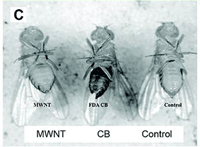Brown University Notes Nanoparticle Effects on Flies

A new study raises the possibility that flies and other insects that encounter nanomaterial "hot spots," or spills, near manufacturing facilities in the future could pick up and transport nanoparticles on their bodies, transferring the particles to other flies or habitats in the environment.
The study on carbon nanoparticles — barely 1/5,000th the width of a human hair —is in the Aug. 15 issue of American Chemical Society's Environmental Science & Technology, a semi-monthly journal.
David Rand and Robert Hurt of Brown University and colleagues note that emergence of a nanotechnology industry is raising concerns about the potential adverse health and environmental effects of nanoparticles. These materials show promise for use in a wide range of products, including cosmetics, pharmaceuticals, and electronics.
The study focused on determining how different kinds of exposure to nanoparticles affected larval and adult fruit flies. There were no apparent ill effects on fruit fly larvae that ate food containing high concentrations of nanoparticles. However, adult flies died or were incapacitated when their bodies were exposed to large amounts of certain nanoparticles. The transfer between flies involved very low levels of nanoparticles, which did not have adverse effects on the fruit flies. Since larvae can tolerate very high doses of nanoparticles in the diet, but adult flies show very different sensitivities, the environmental impact depends on the ecological context of nanoparticle release.
Financial support for the study was provided by the Superfund Research Program, the National Science Foundation, and the Brown University Office of Vice President for Research Seed Fund Program.
To view the article, click on "Differential Toxicity of Carbon Nanomaterials in Drosophila: Larval Dietary Uptake is Benign, but Adult Exposure Causes Locomotor Impairment and Mortality."